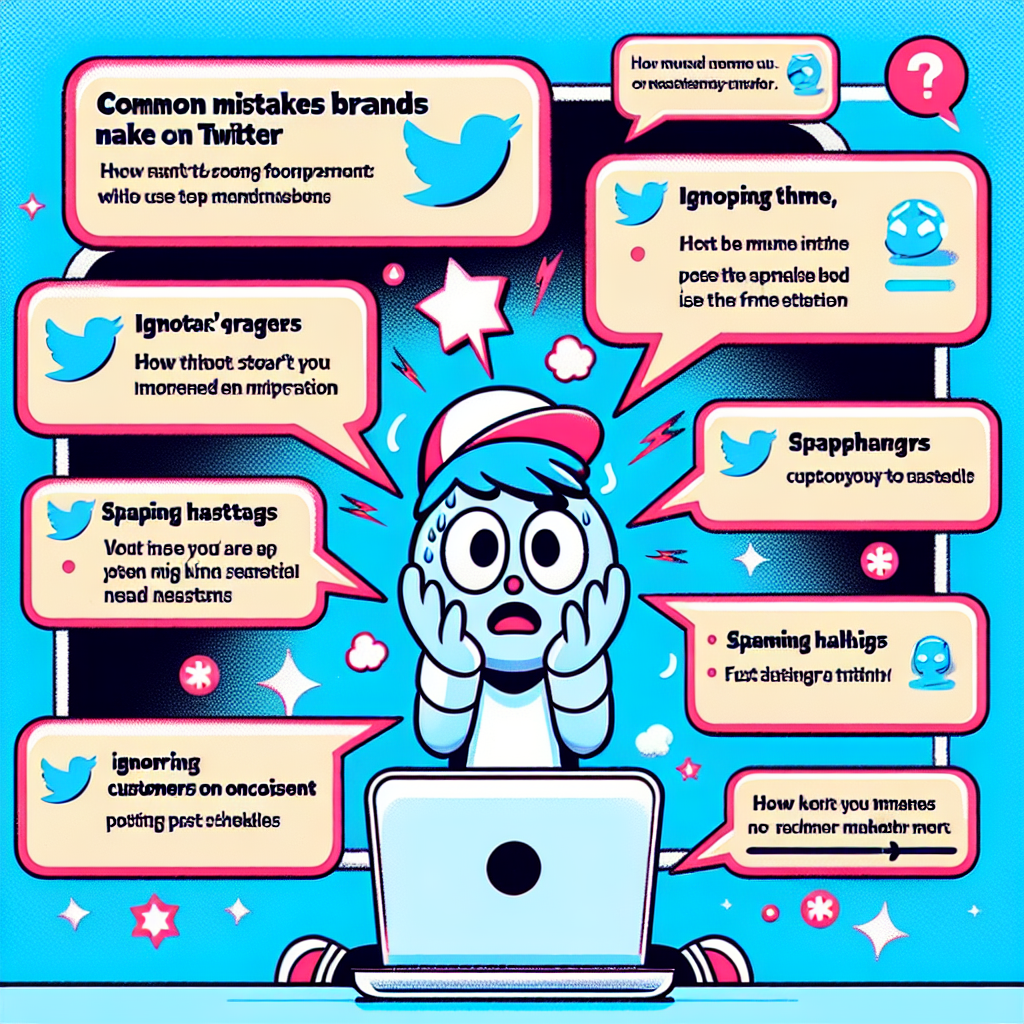Twitter is an undeniable powerhouse in the realm of social media. With over 330 million monthly active users, it serves as a bustling digital town square where brands can engage directly with their audience. Yet, despite its potential, many brands find themselves floundering on this platform. This blog post aims to shed light on the top 10 branding mistakes commonly made on Twitter and provides actionable strategies to avoid these pitfalls. Whether you’re a seasoned social media manager or new to the world of tweets, this guide will equip you with the insights you need to enhance your social media strategy and build a stronger brand presence.
Common Mistakes Brands Make on Twitter
Navigating Twitter effectively requires more than just posting content. Brands often stumble by neglecting key aspects of the platform, leading to branding mistakes that can hinder their success. By understanding these missteps, you can steer clear of them and optimize your brand’s performance.
One frequent mistake is treating Twitter as a one-way communication channel. Brands might focus solely on broadcasting their messages without engaging in meaningful conversations with their followers. This can result in missed opportunities to build stronger relationships and gather valuable feedback.
Another common error is inconsistency in posting. Brands that either overpost or underpost fail to maintain a stable presence. Consistency is crucial for staying relevant and keeping your audience engaged. Without it, your brand can easily be forgotten amidst the noise of endless tweets.
A third mistake involves ignoring the importance of visuals. Twitter is a visually-driven platform, and brands that rely solely on text miss out on capturing the attention of users scrolling through their feeds. Incorporating eye-catching images, GIFs, and videos can significantly enhance your brand’s visibility and engagement.
Ignoring Audience Engagement
Audience engagement is the lifeblood of any successful Twitter strategy. Yet, many brands fail to prioritize meaningful interactions with their followers, leading to lost opportunities for connection and growth.
One mistake is neglecting to respond to mentions and comments. Ignoring followers’ interactions can create a perception of disinterest or arrogance. On the other hand, acknowledging and responding to their messages fosters a sense of community and loyalty.
Brands often overlook the power of retweeting and sharing user-generated content. This not only boosts engagement but also demonstrates that you value your community’s contributions. By showcasing your audience’s creativity, you create a more inclusive and relatable brand image.
Another pitfall is failing to initiate conversations or polls. Encouraging discussions and seeking opinions from your audience not only boosts engagement but also provides valuable insights into their preferences and needs. This information can guide your content strategy and help tailor your offerings to their liking.
Not Using Analytics Effectively
In the realm of social media strategy, data is your compass. However, many brands fail to harness the power of analytics, resulting in missed opportunities for growth and optimization.
One mistake is not regularly monitoring performance metrics. Analytics provide valuable insights into what’s working and what’s not. By analyzing metrics such as reach, engagement, and click-through rates, brands can refine their content strategy and focus on what resonates best with their audience.
Brands often neglect to track follower demographics and behavior patterns. Understanding who your audience is and how they interact with your content allows for more targeted and effective marketing efforts. Tailoring your messaging to suit your audience’s preferences enhances the likelihood of engagement and conversions.
Another common error is failing to adjust strategies based on data insights. Analytics should inform your decisions, guiding you toward what truly works. Whether it’s optimizing posting times or refining content themes, leveraging data-driven insights can lead to more impactful results.

Failing to Adapt Content Strategy over Time
The digital landscape is constantly evolving, and brands that remain stagnant risk becoming irrelevant. Adapting your content strategy is essential to staying current and engaging with your audience effectively.
One mistake is sticking to a one-size-fits-all approach. What worked in the past might not resonate with your audience today. Brands need to be open to experimenting with different content formats and styles to keep their audience interested.
Neglecting to stay updated with trends is another common error. Social media trends can change rapidly, and brands that fail to capitalize on these trends miss out on valuable opportunities to engage with their audience. Keeping an eye on trending topics and incorporating them into your content can make your brand more relatable and timely.
Another pitfall is failing to leverage new platform features. Twitter regularly introduces new tools and features that can enhance your brand’s presence. Staying informed about these updates and integrating them into your strategy can set you apart from competitors and keep your audience engaged.
Neglecting Crisis Management
In today’s fast-paced digital environment, a single tweet can quickly escalate into a larger issue if not handled properly. Therefore, having a robust crisis management strategy for your Twitter account is imperative.
One common mistake brands make is failing to prepare for potential PR crises. Without a clear plan, brands may respond impulsively, exacerbating the situation. It’s crucial to have predefined protocols in place to guide your response and help de-escalate any negative interactions swiftly and professionally.
Another pitfall is ignoring negative feedback or deleting critical comments. This can create a perception of a brand unwilling to listen or improve. Instead, addressing negative comments openly and constructively shows that you value customer input and are committed to transparency and improvement.
Failing to monitor brand mentions diligently can also lead to missed opportunities to mitigate issues before they grow. Keeping a close watch on what people are saying about your brand allows you to catch potential problems early. By staying attuned to audience sentiment, you can proactively address concerns and maintain a positive brand image.
Overlooking Consistent Branding
Maintaining consistent branding is vital to reinforce your brand’s identity and message. However, many brands make the mistake of presenting inconsistent visuals and messaging on Twitter, leading to confusion and a diluted brand presence. Ensuring that your profile picture, header, and bio are aligned with your other marketing channels is fundamental. Consistency in tone, style, and values across all tweets helps to build a recognizable and trustworthy brand.
One frequent error is sporadically changing brand elements without a clear strategy. Abrupt changes can alienate your audience or make your brand appear unfocused. Instead, any updates to branding should be strategic, well-thought-out, and communicated clearly to your audience.
Another oversight is failing to establish and adhere to a brand voice. A distinct voice sets you apart and makes your brand more relatable. Whether it’s formal, humorous, or inspirational, your brand’s voice should align with your values and resonate with your target audience. By ensuring consistent branding, you maintain a strong, cohesive presence on Twitter, nurturing trust and loyalty among your followers.
Ignoring Feedback and Insights
Listening to feedback is a cornerstone of successful social media management, yet many brands overlook the valuable insights they can gain from their audience. Engaging with followers by requesting their opinions on products, services, or content provides a direct line to what customers truly value. When feedback is ignored, brands miss out on opportunities for improvement and growth. Actively seeking and incorporating audience input can refine your offerings and bolster customer satisfaction. Additionally, fostering an environment where followers feel heard and appreciated strengthens brand loyalty and encourages more vibrant community interactions.
Ignoring feedback can also hinder innovation. The social media landscape thrives on fresh ideas and adaptability, with user suggestions often pointing toward untapped potential or emerging trends. By channeling this valuable feedback into actionable strategies, brands can position themselves ahead of the curve, ensuring their social media presence remains dynamic and relevant.
Conclusion and Recommendations
In the fast-paced world of social media, avoiding branding mistakes on Twitter can significantly impact your brand’s success. By addressing common pitfalls such as ignoring audience engagement, underutilizing analytics, and neglecting content adaptation, brands can enhance their social media strategy and build a stronger online presence.
To recap, ensure that your brand’s communication is a two-way street by engaging with your audience and initiating conversations. Leverage analytics to guide your decisions and track performance metrics regularly. Stay adaptable by experimenting with content formats, staying current with trends, and utilizing new platform features.
By implementing these strategies, your brand can not only avoid common mistakes but also thrive in the dynamic landscape of Twitter. Remember, a well-crafted social media strategy is an ongoing process that requires constant evaluation and adjustment.
Ready to elevate your brand’s presence on Twitter? Explore our additional resources or reach out to our experts for personalized guidance. With the right approach, your brand can harness the full potential of Twitter and drive meaningful connections with your audience.









